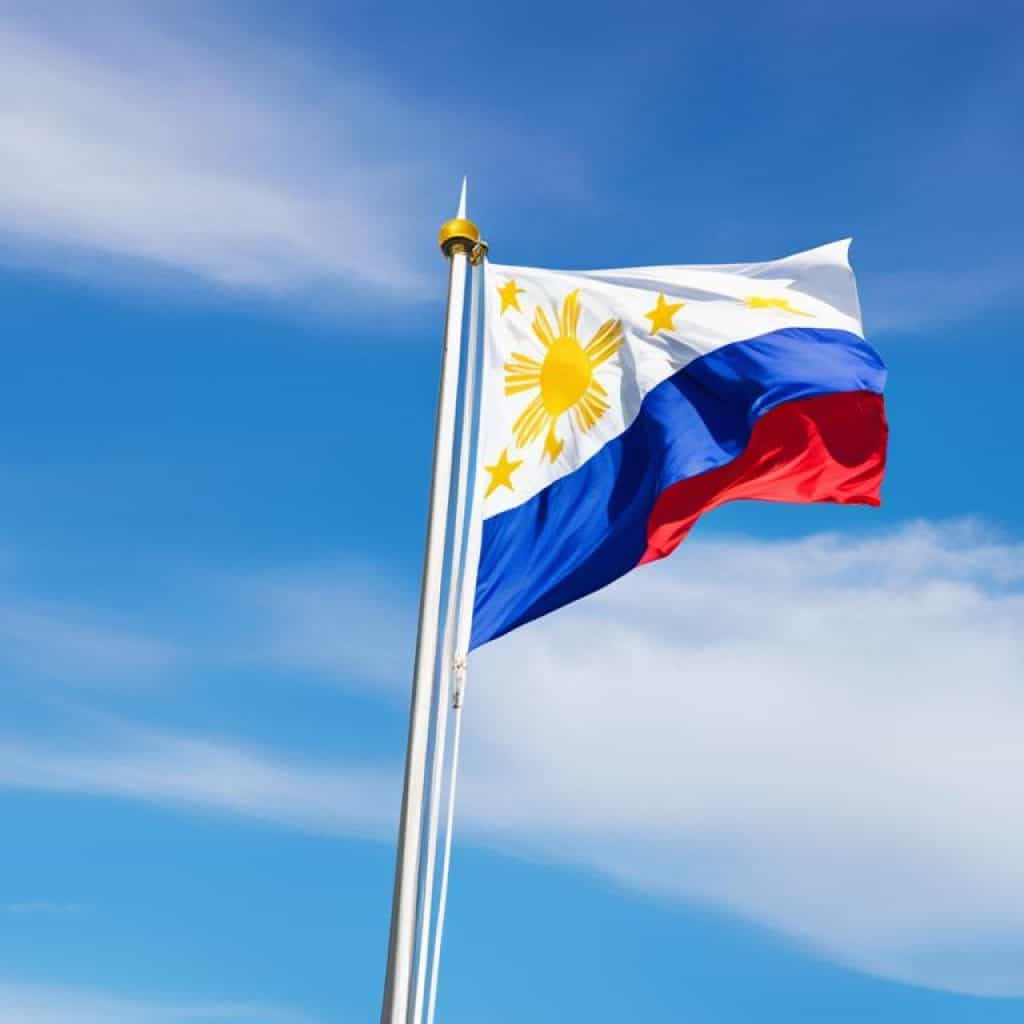Who wrote the national anthem of the Philippines? Many may not know the answer to this intriguing question. It’s time to unveil the composer of the beloved anthem that embodies the spirit and history of the Filipino people. Prepare to be captivated by the remarkable story of Julián Felipe, the mastermind behind the composition of the Philippine national anthem.
Key Takeaways:
- Julián Felipe, a Filipino composer, is the genius behind the Philippine national anthem, known as “Lupang Hinirang”.
- Felipe was born on January 28, 1861, in Cavite City, Philippines, and displayed extraordinary musical talent from a young age.
- He actively participated in the Philippine Revolution against Spanish colonial rule and composed nationalistic songs that inspired his compatriots to fight for independence.
- Emilio Aguinaldo, the leader of the revolution, appointed Felipe to compose a stirring composition for the proclamation of Philippine independence.
- Lupang Hinirang holds immense historical significance and serves as a symbol of national identity and unity for the Filipino people.
Early Life and Musical Training
Julián Felipe, the talented composer behind the Philippine national anthem, Lupang Hinirang, began his musical journey in his early years. Born on January 28, 1861, in Cavite City, Felipe showcased his remarkable musical abilities from a young age, captivating those around him with his innate talent.
His primary education took place in public schools in Cavite and Binondo, Manila, where Felipe’s passion for music continued to flourish. It was during this time that he discovered his proficiency in playing the piano and the organ, allowing him to explore different musical styles and techniques.
In pursuit of honing his skills, Felipe was appointed as an organist at the San Pedro Apostol Parish Church in Cavite Nuevo, where he immersed himself in creating beautiful melodies and harmonies. Furthermore, he became a respected music teacher at La Sagrada Familia, a prominent girls’ school in the area, sharing his wealth of knowledge and inspiring future generations of musicians.
“Music has the power to touch hearts, transform lives, and inspire change. Through his compositions and teachings, Julián Felipe left an indelible mark on the Filipino music scene, becoming a beacon of creativity and innovation.”
Throughout his career, Felipe composed a myriad of popular songs, captivating audiences with his unique style and evocative melodies. Some of his notable works include “Aurorita” and “Reina de Cavite,” which received widespread recognition and earned him various accolades for his outstanding contributions to the world of music.
Witnessing the impact of Felipe’s compositions, it became clear that he possessed an innate ability to create enchanting musical pieces that resonated deeply with listeners. His dedication to his craft and passion for music set the foundation for his illustrious career, ultimately leading him to become the esteemed composer of the Philippine national anthem, Lupang Hinirang.
Julián Felipe’s Notable Works:
| Composition Title | Description |
|---|---|
| “Aurorita” | A captivating composition showcasing Felipe’s melodic prowess and ability to evoke emotions through music. |
| “Reina de Cavite” | An enchanting piece dedicated to the beauty and heritage of Cavite, representing Felipe’s deep connection to his hometown. |
Julian Felipe’s early life and musical training laid the groundwork for his exceptional career as a composer. His dedication and passion for music fostered a legacy that continues to inspire generations of musicians and remains forever engraved in the fabric of the Philippine musical landscape.
Involvement in the Philippine Revolution
Julian Felipe played a crucial role in the Philippine Revolution, standing alongside his fellow Caviteños in the fight against Spanish colonial rule. He fought valiantly against the Spaniards, demonstrating his unwavering commitment to the cause of independence. However, his efforts were met with consequences as he was arrested and imprisoned at Fort San Felipe in Cavite, along with the “Thirteen Martyrs of Cavite.” Despite the execution of his comrades, Felipe was declared innocent and released in June 1897.
After his release, Julian Felipe rejoined the troops led by Emilio Aguinaldo, and his passion for his country’s freedom found expression in music. He composed powerful and nationalistic songs that inspired his compatriots to continue the fight for independence.
| Key Points | Details |
|---|---|
| Lupang Hinirang Creator | Julian Felipe composed the Philippine national anthem, known as Lupang Hinirang. |
| Julián Felipe’s Role in the Revolution | Felipe actively participated in the Philippine Revolution against Spanish colonial rule, fighting alongside his fellow Caviteños. |
| Imprisonment and Release | Felipe was arrested and jailed at Fort San Felipe but was later found innocent and released in June 1897. |
| Continued Contribution to the Cause | After his release, Felipe rejoined Emilio Aguinaldo’s troops and composed nationalistic songs that inspired his compatriots. |
This period of involvement in the revolution showcases Julian Felipe’s dedication to the fight for Philippine independence and the immense influence he exerted through his music, including the creation of the iconic Lupang Hinirang.
Composition of the National Anthem
Emilio Aguinaldo, the leader of the Philippine Revolution, recognized the need for a powerful composition to accompany the historic proclamation of Philippine independence. To fulfill this task, Aguinaldo approached Julián Felipe, a renowned Filipino composer, to create an anthem that would inspire the Filipino people.
On June 12, 1898, during the momentous event at Aguinaldo’s home in Kawit, the composition by Julián Felipe, originally titled “Marcha Nacional Filipina,” resounded for the first time. This stirring melody would later become the anthem of the revolutionary First Philippine Republic, established in 1899, and known today as “Lupang Hinirang,” the national anthem of the Philippines.
Emilio Aguinaldo and Julián Felipe collaborated closely, with Aguinaldo providing the vision for a composition that captured the essence of the Filipino spirit. Felipe, using his musical expertise and patriotic fervor, composed an anthem that would stand as a testament to the country’s struggle for independence.
This collaboration between Emilio Aguinaldo and Julián Felipe resulted in a timeless masterpiece that embodies the soul of the Filipino people. The anthem’s solemn yet uplifting melody and the poignant lyrics, originally written by José Palma, continue to resonate with Filipinos, inspiring patriotism and fostering a sense of national unity.
“The national anthem is a powerful expression of our unwavering love for our country. It stirs emotions, evokes memories, and reminds us of the sacrifices made by our forefathers. Julián Felipe’s composition, in collaboration with Emilio Aguinaldo, has become our nation’s musical soul, etching itself into the hearts of every Filipino.”
Julián Felipe’s legacy as the composer of the Philippine national anthem holds a significant place in the country’s history and cultural identity. Indeed, his collaboration with Emilio Aguinaldo created a melody that still resounds across the archipelago, serving as a reminder of the Philippines’ hard-fought journey towards independence and unity.
Julián Felipe and Emilio Aguinaldo Collaboration
To honor their collaboration and the profound impact of their work, a bust of Julián Felipe stands in Cavite City, paying tribute to his instrumental role in composing a symbol of national pride. Furthermore, Felipe’s creation of the national anthem is a testament to the power of artistic collaboration in shaping a nation’s identity.
| Emilio Aguinaldo’s Role | Julián Felipe’s Contribution |
|---|---|
| Provided the vision for a stirring composition to accompany the proclamation of Philippine independence | Composed the powerful and uplifting anthem that resonates with the Filipino people |
| Collaborated closely with Julián Felipe to articulate the essence of the Filipino spirit | Infused his musical expertise and patriotism into the composition, capturing the country’s struggle for freedom |
| Recognized the anthem’s significance as a symbol of unity and national identity | Created a timeless masterpiece that continues to inspire patriotism and foster a shared sense of pride |

The collaboration between Emilio Aguinaldo and Julián Felipe resulted in a composition that encapsulates the spirit of the Filipino people, expressing their resilience, patriotism, and love for their homeland.
Later Life and Contributions
After the Philippine–American War, Julián Felipe’s musical journey continued with great dedication and passion. Despite facing imprisonment by the Americans at Fort Santiago in Intramuros, Felipe remained committed to his craft and made significant contributions to the field of music.
In 1899, President Emilio Aguinaldo appointed Felipe as the Director of the National Band of the First Philippine Republic. This prestigious role allowed Felipe to showcase his musical expertise and lead a renowned ensemble representing the newly independent nation. His directorship of the National Band further solidified his status as a prominent figure in Philippine music.
In addition to his role as Director, Julián Felipe also served as a music teacher. From 1902 to 1942, he dedicated his time and knowledge to teaching piano lessons, nurturing the musical talents of aspiring musicians and imparting a deep appreciation for music.
“Music has the power to unite people, to inspire change, and to evoke emotions. Through his role as Director of the National Band and his dedication to teaching, Julián Felipe played a pivotal role in shaping the musical landscape of the Philippines.”
While Felipe is widely renowned for his composition of the national anthem, his musical repertoire extended beyond “Lupang Hinirang”. Some of his notable works include “Hail to the Chief,” a composition paying homage to prominent figures, “Douglas MacArthur March,” dedicated to the American general, and “Un Recuerdo,” a heartfelt tribute to the Thirteen Martyrs of Cavite. These compositions showcase Felipe’s versatility and his ability to captivate audiences with his musical creations.
The later years of Julián Felipe’s life were marked by his unwavering dedication to music and his continuous pursuit of excellence. His contributions to Philippine music, both as a composer and as a music educator, have left an indelible mark on the country’s cultural heritage.
Death and Legacy
Julián Felipe, the talented composer behind the Philippine national anthem, left a lasting legacy before his passing on October 2, 1944, in Sampaloc, Manila, during World War II. His musical contributions and his pivotal role in crafting the anthem have etched his name in Philippine history.
To honor his memory and commemorate his remarkable achievements, a bust of Julián Felipe stands proudly in Cavite City, near San Sebastian College – Recoletos de Cavite. Moreover, the people of Cavite City have named a public elementary school and an auditorium at De La Salle University–Dasmariñas after him, showcasing their admiration and recognition of his musical prowess.
In recognition of his immense cultural contributions, the Philippine government passed Republic Act No. 7805 in 1994, declaring January 28 of every year as a non-working holiday in Cavite City. This special day, known as “Julian Felipe Day,” serves as a testament to the significance and impact of his musical legacy in the Philippines.
“Julián Felipe’s musical genius continues to resonate in the hearts of Filipinos, reminding us of the power of music to unite a nation and inspire patriotism.”
Historical Significance of Lupang Hinirang
Lupang Hinirang, the Philippine national anthem composed by Julián Felipe, holds great historical significance for the Filipino people. It serves as a powerful symbol of the nation’s struggle for independence and the sacrifices made by the revolutionaries who fought for freedom.
The anthem’s lyrics were initially written in Spanish by José Palma and have since been adapted into Filipino and English translations. Throughout Philippine history, Lupang Hinirang has played an integral role in significant events such as the proclamation of independence and various national celebrations.
“Lupang Hinirang stands as a testament to the unwavering spirit and resilience of the Filipino people. It brings to life the collective aspirations for a sovereign nation, inspiring generations to continue striving for a better future.”
– National Historical Commission of the Philippines
As Filipinos sing Lupang Hinirang, they are reminded of the sacrifices and determination that paved the way for the country’s independence. It instills a sense of national pride and unity, fostering a shared identity among the Filipino people.
The anthem’s message of patriotism and love for the homeland resonates deeply, serving as a constant reminder of the historical struggles that shaped the nation. It embodies the ideals and values that Filipinos hold dear, creating a cultural connection that transcends generations.
Evolution of the National Anthem
Over the years, the national anthem of the Philippines, Lupang Hinirang, has undergone changes in its lyrics and musical arrangement, reflecting the country’s evolving history and cultural identity.
The original lyrics of the anthem were written in Spanish by José Palma in 1899. Since then, translations into Filipino and English have been introduced to accommodate the diverse linguistic landscape of the Philippines. The current Filipino version of the anthem, “Lupang Hinirang,” was officially adopted in 1956, solidifying its status as the nation’s anthem.
The musical arrangement composed by Julián Felipe has remained consistent over the years, serving as the enduring foundation of the anthem. However, minor revisions were made in the 1960s by Felipe Padilla de León to enhance the anthem’s musicality while maintaining its essence.
In the 1920s, the anthem’s time signature was changed from 2/4 to 4/4, allowing for a more rhythmic and stirring rendition. Additionally, the key of the anthem was modified from C major to G, providing a more resonant and uplifting melody.
Evolution of “Lupang Hinirang”
| Year | Evolution |
|---|---|
| 1899 | Original lyrics written in Spanish by José Palma |
| Mid-20th century | Introduction of translations into Filipino and English |
| 1956 | Official adoption of the Filipino version, “Lupang Hinirang“ |
| 1960s | Minor revisions made to the musical arrangement by Felipe Padilla de León |
| 1920s | Change in time signature from 2/4 to 4/4 |
| 1920s | Modification of the anthem’s key from C major to G |
Legal Recognition of the National Anthem
The legal recognition and regulations surrounding the Philippine national anthem are outlined in the Flag and Heraldic Code of the Philippines. Republic Act No. 8491, passed on February 12, 1998, codified the lyrics of “Lupang Hinirang” into law. This act specifies that the national anthem must always be sung in the national language, both within and outside the country. Any violation of this law is punishable by a fine and imprisonment. The Flag and Heraldic Code plays a crucial role in ensuring the proper and respectful treatment of the national anthem.
Cultural Impact of Lupang Hinirang
Lupang Hinirang, the national anthem of the Philippines, holds immense cultural significance for the Filipino people. It serves as a powerful symbol of national identity and unity, resonating deeply with the hearts and minds of the citizens.
Lupang Hinirang is prominently sung during official events, national celebrations, and sporting competitions, igniting a sense of pride and patriotism in Filipinos. The anthem’s lyrics and stirring melody evoke emotions of remembrance and gratitude for the struggles and sacrifices made to achieve independence.
Generations of Filipinos have grown up with the anthem, which has become an integral part of their cultural fabric. As the familiar words and harmonies are passed down through the years, Lupang Hinirang fosters a collective consciousness and strengthens the bonds of national unity.
“Lupang Hinirang instills in us a profound sense of belonging and a shared commitment to our nation’s ideals. It unites us as one people, bridging geographical and cultural divides.” – Prominent Filipino historian
The profound cultural impact of Lupang Hinirang extends beyond musical appreciation. It represents the culmination of the Filipino nation’s struggles, resilience, and unwavering spirit. Through the anthem, Filipinos find inspiration to overcome challenges and strive for a better future.

National Anthem’s Influence on Filipino Culture
| Aspect | Description |
|---|---|
| 1. National Identity | Lupang Hinirang reinforces a strong sense of national identity and pride among Filipinos. |
| 2. Unity | The anthem plays a vital role in fostering unity and solidarity among diverse cultural groups. |
| 3. Emotional Connection | As a deeply ingrained symbol, the anthem evokes intense emotions and a shared sense of belonging. |
| 4. Historical Remembrance | The lyrics and melody serve as a reminder of the nation’s history, struggles, and triumphs. |
| 5. Inspiration for Progress | Lupang Hinirang inspires Filipinos to work towards a prosperous and united nation. |
The cultural impact of Lupang Hinirang transcends borders, with international audiences often witnessing its stirring melodies at various sporting events and global platforms. Through these performances, the anthem showcases the rich cultural heritage of the Philippines and promotes awareness and appreciation of Filipino history and values.
In conclusion, Lupang Hinirang has left an indelible mark on Filipino culture and society. It stands as a testament to the nation’s unity, resilience, and unwavering spirit. With its powerful melodies and resonant lyrics, the national anthem continues to inspire and unite generations of Filipinos, exemplifying the enduring cultural significance and role in fostering national unity.
International Recognition of the National Anthem
The Philippine national anthem, Lupang Hinirang, has garnered global recognition through captivating performances on international stages. The anthem’s melodic resonance and profound cultural significance have made it a prominent feature in major events worldwide. Notably, Lupang Hinirang has been proudly played during the Olympics, where Filipino athletes compete, symbolizing their unwavering national pride and resilience.
Each performance of Lupang Hinirang on the global stage showcases the rich tapestry of Filipino cultural heritage, evoking a sense of unity and inspiring audiences around the world. The anthem serves as a powerful representation of the aspirations and spirit of the Philippines, leaving an indelible impression on international audiences and promoting greater awareness and appreciation of Filipino culture and history.
Through these international showcases, Lupang Hinirang embodies the country’s commitment to celebrating its roots and fostering a sense of national identity beyond its borders. The anthem’s resonance on the global stage serves as a beacon of pride for Filipinos worldwide, connecting diverse communities and reinforcing the values that make the Philippines a unique and vibrant nation.
Controversies and Debates Surrounding Lupang Hinirang
The national anthem of the Philippines, Lupang Hinirang, has been the subject of intense debates and discussions, sparking controversies over proposed revisions and amendments. Some individuals have presented ideas to alter the lyrics or musical arrangement, aiming to make the anthem more accessible or relevant in today’s society.
These proposed changes, however, have not been implemented into law, and the original version of Lupang Hinirang, composed by Julián Felipe, remains officially recognized and protected by the Flag and Heraldic Code of the Philippines.
Debates surrounding Lupang Hinirang reflect the deep importance and sensitivity associated with national symbols. The anthem represents the history, pride, and unity of the Filipino people, and any proposed alterations must be approached with careful consideration to preserve its cultural significance.
Education and Awareness of the National Anthem
Educating the younger generation about the national anthem is crucial in preserving its significance and fostering national pride. By teaching Lupang Hinirang in schools across the Philippines, students have the opportunity to learn not only the lyrics and musical composition but also the historical context and cultural importance of this national symbol.
Through dedicated education programs and initiatives, schools aim to instill in students a deep appreciation for the national anthem and its role in the country’s history and identity. By understanding the meaning behind the words and the emotions conveyed through the melody, students develop a sense of connection and belonging to their country.
Teaching the national anthem goes beyond mere memorization. It contributes to the cultural and civic education of students, allowing them to engage in discussions about national identity, independence, and the significance of unity. It fosters a sense of patriotism and instills the values of respect and honor towards their country and its heritage.
“Education is the passport to the future, for tomorrow belongs to those who prepare for it today.” – Malcom X
Understanding the national anthem is not limited to the classroom. Schools encourage students to actively participate in national events and ceremonies where the national anthem is sung. This provides them with experiential learning opportunities, reinforcing their understanding and connection to the anthem.
By equipping students with knowledge about the national anthem, schools play a crucial role in shaping future citizens who deeply appreciate and respect their country’s traditions and values. It is through education and awareness that the significance of Lupang Hinirang will be preserved for generations to come.

Public Performances and Etiquette of the National Anthem
Proper rendition and etiquette are essential when performing or observing the national anthem, Lupang Hinirang. The anthem should be sung with respect and reverence, reflecting the solemnity and significance it holds for the Filipino people.
When the national anthem is played, it is customary to stand at attention with the right hand placed over the heart. This gesture signifies patriotism and shows respect for the anthem and the country it represents. It is important to maintain a respectful and solemn demeanor throughout the performance.
Any inappropriate behavior during the rendition of the national anthem should be avoided. This includes talking, engaging in distracting activities, or showing any form of disrespect. The focus should be on honoring the anthem’s importance and upholding the values it represents.
Public performances of the national anthem should adhere to these guidelines to create a unified and respectful atmosphere. By following these etiquette practices, individuals contribute to the overall reverence and cultural significance of Lupang Hinirang.
Conclusion
Julián Felipe, the esteemed composer of the Philippine national anthem, has left an indelible mark on the cultural heritage of the Philippines. His composition, Lupang Hinirang, stands as a powerful symbol of the nation’s fight for independence and embodies the spirit of Filipino pride. The national anthem has played a vital role in fostering a sense of unity and identity among the Filipino people, resonating with their shared struggles and aspirations.
Lupang Hinirang has not only captivated audiences within the Philippines but has also garnered international recognition. Its performances on the global stage, such as the Olympics, have showcased the rich cultural heritage of the country and brought awareness to the Filipino spirit. The historical significance and cultural impact of the national anthem are a testament to the enduring legacy of Julián Felipe.
As an emblem of national pride, Lupang Hinirang holds a special place in the hearts of Filipinos. It is taught in schools, ensuring that the younger generation understands the importance of the anthem and its role in shaping the country’s history. Public renditions of the national anthem adhere to proper etiquette, with individuals standing in respectful silence, hand over heart, to honor the anthem’s solemnity.
Julián Felipe’s timeless composition, Lupang Hinirang, continues to inspire and unite the Filipino people. Its melodies and lyrics serve as a powerful reminder of the struggles and sacrifices of the past, driving the nation towards a future filled with hope and resilience. The national anthem remains an integral part of the Philippine cultural landscape, igniting the flame of patriotism in the hearts of all who hear its resounding refrain.


















Add comment